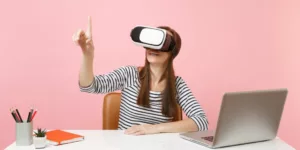VR is a mess right now with so many companies convinced that collaboration and education over Virtual Reality requires classroom or conference room metaphor to function. But both the classroom and the conference room are constructs based on having to be in the same location physically which is not a requirement for virtual reality where your imagination, not your physical body, define the related construct.
Right before the holiday break (in the US we mostly shut down during the last two weeks of the year), I took a briefing from Lenovo’s VR Classroom group and it is the first one in a long time where the approach optimized the toolset and did not try to recreate something that no longer made sense.
Let us talk about why Lenovo’s VR Classroom is a better approach to remote education than the more common approach using avatars and virtual classrooms or conference rooms.
The Recurring Mistake
When we have a disruptive technology change, we tend to take the new technology and force it to do what we did before that technology emerged. The first cars were not only called horseless carriages, but they looked like horse-drawn carriages without the horses. So, it is not surprising that so many of the collaboration tools we use try to recreate classrooms, conference rooms, even auditoriums at times failing to realize that every one of those constructs is optimized for physical bodies and defined by the need for everyone to be in the same place to communicate.
There is something to be said for familiarity but using a technology that is optimized for people who are remote by faking an in-person event would seem to be suboptimal because physical rooms are limited while our imaginations and the VR technology we are now using have very different limitations and advantages.
In addition, when we learn or collaborate the focus should be on either the project we are collaborating about or the material we are learning. For instance, if we were collaborating on a building would not it make more sense, if we could, go to the building site and do that work where the building is going rather than in a conference room remote from that site?
While expensive and time-consuming to do that physically, with a VR solution you can go anyplace instantly, making location learning and collaboration far more interesting and effective.
Lenovo’s VR Classroom
This is what Lenovo has figured out with their VR Classroom. They created a process where the focus is on the material to be learned and the engagement of the students rather than trying to recreate a virtual classroom. Using the Lenovo Mirage VR S3 headset, which emerged from their partnership with Pico, Lenovo created a comprehensive learning platform that focused students on the content to be learned and does not try to recreate the classroom experience. Using eye-tracking teachers can tell whether the students are engaged and refine the related content over time to increase engagement. They can better focus on the content and have reported accelerated learning speeds and less behavioral problems because they can better monitor the students and fine-tune the curriculum to provide the desired outcome.
Tests are more interactive and focused more on reinforcing knowledge as opposed to the more typical mix of memorization and test-taking skills. Training speed, rather than the more typical limitation of being set by the slower students, is more dynamic and designed to move at the rate optimal for any student. This helps both slow and fast students by assuring the slow students are not left behind and the fast students do not disengage out of boredom.
While Lenovo’s initial rollout of this program focused on K-12 education exclusively it has since expanded to all levels of schools and includes professional training as well now. The solution is comprehensive as well with hardware, content, device management, and training and support. All these elements are required because teachers and trainers want to focus on the job of teaching, not on having to do their own installation and ongoing service and support. By taking on these burdens, Lenovo allows the teacher/trainer to do what they do best, which is teaching and training.
Interesting courses include things like ethical finance, and they can do the avatar thing using Mozilla Hubs if needed for group games and team-building activities. But the overall effort is to place the student immersivity into the content to be learned and focusing on the transfer of knowledge, not the recreation of the classroom to speed the learning process.
Wrapping up:
I think that many of the VR efforts that try to replicate classrooms, conference rooms, and auditoriums are wrong-headed because they create artificial limitations on the process based on physical requirements that do not exist in the virtual world. Lenovo’s VR Classroom 2 effort appears to better take into account the capabilities and limitations of VR to craft a far more effective solution.
The lesson here is that the best solutions focus first on the problem to be solved using the unique advantages of the new tool and rather than recreating the limitations of the old one. Lenovo’s approach is exactly that, they focused on VR’s ability for immersive learning and the result is a remote solution that is potentially far more effective than the in-person process it replaces.








